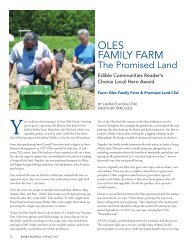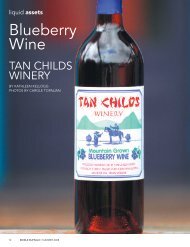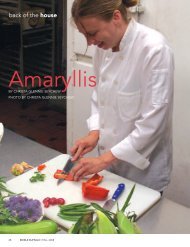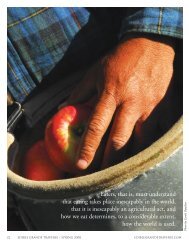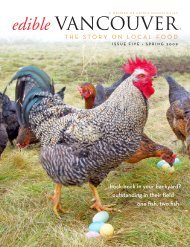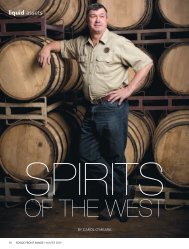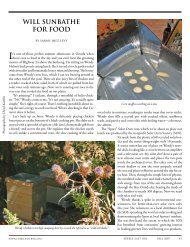gary guthrie: the carrot king - Edible Communities
gary guthrie: the carrot king - Edible Communities
gary guthrie: the carrot king - Edible Communities
You also want an ePaper? Increase the reach of your titles
YUMPU automatically turns print PDFs into web optimized ePapers that Google loves.
<strong>gary</strong> <strong>guthrie</strong>:<br />
<strong>the</strong> <strong>carrot</strong> <strong>king</strong><br />
by jay wagner<br />
Consider <strong>the</strong> ordinary <strong>carrot</strong>. It’s a decent snack: crunchy, slighty<br />
sweet, satisfying. I’ve been eating ‘em for years, often as an afternoon<br />
snack.<br />
But I had never truly experienced a <strong>carrot</strong> until I met Gary<br />
Guthrie, a Nevada farmer. According to <strong>the</strong> USDA, <strong>carrot</strong>s are<br />
<strong>the</strong> fifth most consumed vegetable in <strong>the</strong> country; Americans eat<br />
an average of 9.5 pounds each year. But in 2003, <strong>the</strong> year I sampled<br />
my first Guthrie-grown <strong>carrot</strong>, my family consumed nearly 40<br />
pounds of <strong>the</strong>m in <strong>the</strong> span of three months. They are that good.<br />
Here’s <strong>the</strong> thing about supermarket <strong>carrot</strong>s: <strong>the</strong>y are bred to<br />
be mechanically harvested, withstand shipping across <strong>the</strong> country<br />
(most <strong>carrot</strong>s come from California, which produces 76 percent<br />
of <strong>the</strong> nation’s <strong>carrot</strong>s) and sit on <strong>the</strong> shelf at <strong>the</strong> grocery<br />
store for weeks. The average <strong>carrot</strong> travels 1,700 miles from farm<br />
to grocery store. And it tastes like it.<br />
The first time I ate one of one of Guthrie’s<br />
<strong>carrot</strong>s at <strong>the</strong> Iowa Vegetable Growers conference<br />
in Ames, I was so surprised by <strong>the</strong> flavor<br />
that I giggled after my first bite. Then I looked<br />
around to see if anyone was watching me and I<br />
ate ano<strong>the</strong>r. And <strong>the</strong>n ano<strong>the</strong>r. And ano<strong>the</strong>r.<br />
Guthrie says he never intended to be Iowa’s<br />
<strong>carrot</strong> <strong>king</strong>. He started raising vegetables in<br />
1997 and experimented with a number of heirloom<br />
vegetables, including <strong>carrot</strong>s. Gary farms<br />
with his wife, Nancy, and son, Eric, on Growing<br />
Harmony farm, located between Nevada<br />
and Ames in central Iowa. He grew up here but<br />
left Iowa to work in community development<br />
in Central America for <strong>the</strong> Mennonite Central<br />
Committee.<br />
When he decided to try his hand at vegetable<br />
production, he began a Community Supported<br />
Agriculture system, in which consumers support<br />
a local farm by paying in advance for agricultural<br />
products. This reduces <strong>the</strong> financial risks for <strong>the</strong><br />
farmer because <strong>the</strong> costs of seeds and planting<br />
crops are covered in advance by consumers.<br />
Throughout <strong>the</strong> growing season, CSA members<br />
receive a portion of <strong>the</strong> farm’s harvest each week.<br />
If <strong>the</strong> crop fails, everyone loses; but when <strong>the</strong>re’s<br />
a bumper crop, everyone sees <strong>the</strong> benefits.<br />
Guthrie was loo<strong>king</strong> for a way to supplement<br />
his CSA income and decided that <strong>carrot</strong>s<br />
make economic sense because of <strong>the</strong>ir long<br />
shelf life. With <strong>carrot</strong>s, he could market <strong>the</strong>m<br />
through <strong>the</strong> fall, maximizing sales potential.<br />
That is, if <strong>carrot</strong> fans like me haven’t hoarded all<br />
of Guthrie’s product we can get our hands on.<br />
Guthrie experiments with a variety of <strong>carrot</strong><br />
varieties, but his most popular is <strong>the</strong> Bolero,<br />
which does well in cool wea<strong>the</strong>r. Guthrie says<br />
he realized how good <strong>the</strong> Bolero was when he<br />
pulled some strays out of <strong>the</strong> ground after snow<br />
had fallen in December, 1997. The taste, he says,<br />
was unlike anything he had ever experienced.<br />
10 SPRING 2007 EDIBLE IOWA RIVER VALLEY
Photo by Carole Topalian<br />
During <strong>the</strong> next year, he began to research <strong>the</strong> best ways to<br />
grow <strong>carrot</strong>s and sought out studies comparing varietals. Bolero<br />
constantly came out on top and he made it is trademark <strong>carrot</strong>.<br />
Researchers found that unlike o<strong>the</strong>r vegetables, a tasty <strong>carrot</strong> will<br />
taste <strong>the</strong> same regardless of where it’s grown. Intrigued, he increased<br />
production.<br />
Guthrie farms entirely by hand, a backbrea<strong>king</strong> enterprise for<br />
a vegetable farm as large as his. He raises a half-dozen varieties of<br />
<strong>carrot</strong>s and is constantly trying out new types (his CSA customers<br />
are sometimes invited to <strong>carrot</strong> tasting parties at his farm) but<br />
<strong>the</strong> end of <strong>the</strong> season Bolero is his most popular. O<strong>the</strong>r <strong>carrot</strong>s<br />
that he recommends include <strong>the</strong> mid-summer Nelson, <strong>the</strong> fall<br />
Mokum, <strong>the</strong> Ithaca, and <strong>the</strong> Sugarsnax.<br />
During 2006, Guthrie grew nearly 5,000 pounds of <strong>carrot</strong>s<br />
Carrot lovers can find Guthrie’s gems through o<strong>the</strong>r farmers operating<br />
CSAs, a handful of retailers (like <strong>the</strong> Wheatsfield Co-op<br />
in Ames), and some selected restaurants in <strong>the</strong> region. Consumers<br />
on <strong>the</strong>ir own personal <strong>carrot</strong> hunt can also call Growing Harmony<br />
Farm for direct sales.<br />
Growing Harmony Farm<br />
Gary Guthrie<br />
58444 260th St<br />
Nevada, Iowa 50201<br />
515.382.3117<br />
EDIBLE IOWA RIVER VALLEY SPRING 2007



